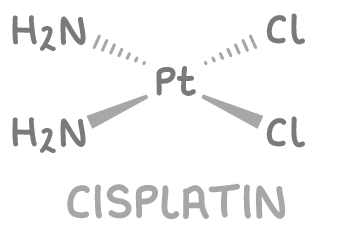The Action of Anti-Cancer Drugs
This lesson covers:
- What cisplatin is and how it works as an anti-cancer drug
- Why cisplatin causes side effects
Cisplatin is a platinum-based anti-cancer drug
Cisplatin is a complex of platinum(II) bound to two chloride ions and two ammonia molecules in a square planar arrangement. Its formula is Pt(NH3)2Cl2.

The drug is widely used in chemotherapy to treat a variety of cancers.
It targets cancer cells by attaching to their DNA, which hinders their ability to replicate. This action effectively halts the growth of tumours.
Cisplatin binds to DNA through ligand substitution
When cisplatin enters a cancer cell, it can bind to the cell's DNA through ligand substitution reactions.
This process causes DNA damage:
- A nitrogen atom on a guanine DNA base forms a coordinate bond with cisplatin's central platinum ion, displacing a chloride ligand.
- A second guanine nitrogen from the opposite DNA strand bonds to the platinum, displacing the other chloride ligand.
- This results in crosslinking that causes kinks in the DNA structure.
- The altered DNA cannot unwind or replicate as it normally would.
By interfering with the DNA replication process, cisplatin prevents cancer cells from multiplying. Cancer cells divide more rapidly than most healthy cells, making them more susceptible to the effects of cisplatin.
Effects on healthy cells
Unfortunately, cisplatin can also bind to DNA in healthy cells, especially rapidly dividing ones like hair follicles and bone marrow. This binding can prevent the cells from replicating properly.
This leads to several side effects, including:
- Hair loss - due to damage to hair follicle cells.
- Suppressed immune system - This is because of the impact on bone marrow cells, which are crucial for producing white blood cells.
- Kidney damage - This is because the kidneys work to filter and excrete the drug.
To mitigate these side effects, the dosage of cisplatin is kept low, and research is ongoing to develop methods that target the drug more precisely to cancer cells.
Despite its side effects, cisplatin remains a valuable tool in cancer treatment due to its effectiveness in stopping tumour growth. The treatment regimen is carefully planned to balance the benefits against the potential risks.